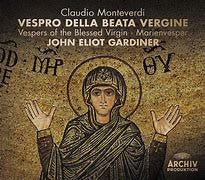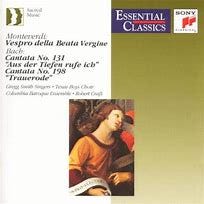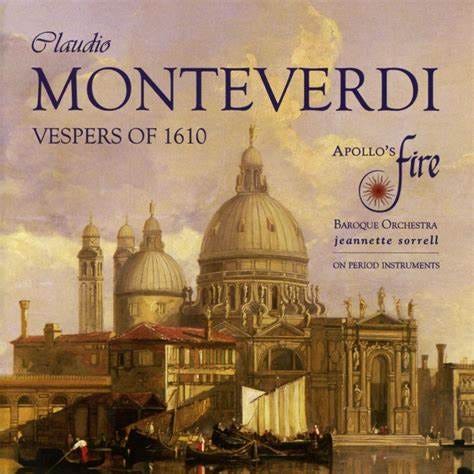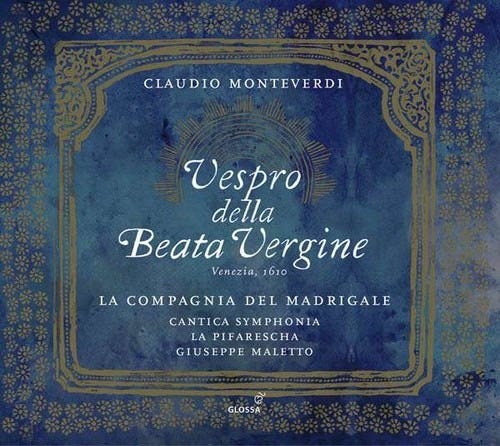Building a Collection #79: Monteverdi's Vespro della Beata Vergine (Vespers of the Blessed Virgin or Vespers of 1610)
With recommended recordings
Building a Collection #79
Vespro della Beata Vergine (Vespers of the Blessed Virgin or Vespers of 1610)
By Claudio Monteverdi
____________
“...no doubt all professions have their hazards, and for the student of Monteverdi the principal one is surely that musicological Lorelei, the Vespers (of 1610, of course). To edit it is to receive the kiss of death as a scholar. To perform it is to court disaster. To write about it is to alienate some of one’s best friends”
- Denis Arnold, Cambridge Music Handbook
Welcome back to Building a Collection, where we have arrived at #79 on our list of the top 250 classical works of all-time. At #79 is Renaissance composer Claudio Monteverdi’s masterpiece, the Vespro della Beata Vergine (Vespers of the Blessed Virgin). Monteverdi’s Vespers is full of a variety of styles and structures, mixing solo singing with polyphonic singing, and including recitative and continuo singing. It was groundbreaking in its overall impact, and still remains one of the very finest examples of Renaissance musical art.
Claudio Monteverdi
Claudio Monteverdi (1567 – 1643) was an Italian composer that probably more than any other composer is credited with bridging the transition from the Renaissance period to the Baroque period in music. If you trace Monteverdi’s progress from his earliest works to his latest works, the shift in musical thinking was significant. Moving from Renaissance polyphony to Baroque splendor did not happen overnight, and along the way Monteverdi was the target of quite a lot of criticism due to his alleged expressive “imperfections”. At the time, the rules of musical counterpoint superseded expressive considerations. What Monteverdi did was use music to express the text by whatever means necessary, including using so-called incorrect counterpoint techniques. Thankfully his incorrectness blazed a trail into a new, fertile period of musical development.
Monteverdi worked in the court of the Gonzaga family in Mantua, Italy from 1590 to 1612. Eventually he would have differences with the Gonzaga court and would look for work elsewhere. In 1612 he was appointed maestro di cappella at St. Mark’s Cathedral in Venice, a post he would hold for the rest of his life. Importantly, Monteverdi was really the earliest composer of “opera” that still has his works regularly performed today. In fact, the word opera had not been invented yet. He is known especially for the ground-breaking opera Orfeo from 1607, and others such as L’incoronazione di Poppea which are still performed regularly today. However, there was a very long period of time when Monteverdi’s music was forgotten and not performed. From around the 1950s, interest in his music has been revived gradually and since then it has been performed and recorded regularly.
Vespro della Beata Vergine (Vespers of the Blessed Virgin or Vespers of 1610)
Sometimes I tire of listening to most music from the Renaissance period, which is why Monteverdi is so refreshing. Even though he was really a baroque composer in his style, he was still using instruments and techniques from the Renaissance. When we turn to his Vespers, what we hear is a bold, new style that is almost operatic, and includes dances, concerti sections for voices and orchestra, and various accompanying instruments. He needed to compose a work for the Feast of the Assumption of Mary, and hence the Vespers were written for the occasion. However, the resulting work really goes beyond just liturgical music since some of the texts chosen by Monteverdi were certainly controversial and non-traditional.
Vespers is based on the evening prayer from the daily office or Canonical Hours taken from the official daily prayers of the Roman Catholic Church. The prayers are psalms, hymns, canticles, and readings with responsories. It is speculated that Monteverdi wrote these Vespers with the cathedral of St. Mark’s in Venice specifically in mind, due to the extremely resonant acoustics of the space. There are various galleries, balconies, and lofts throughout the church and the music seems designed to take advantage of the echoing and immersive quality produced within the space.
The piece begins with nearly the same brass fanfare and toccata that is heard at the beginning of his opera Orfeo. It is a stunning beginning that awakens the senses and raises the spirit. Between the psalms, Monteverdi places movements termed concertos or sonatas from biblical sources, and again where this piece diverges from tradition at the time, there is often a theatrical feel to the music. While this may sound odd to anyone attending a Roman Catholic Mass today, at the time it was apparently common practice in Venice to include non-liturgical music in the service. You may be aware that in a traditional Mass where the parts of the Mass are sung to a particular musical setting, it was conventional to precede the music with a “plainchant” antiphon appropriate to the feast day. However, Monteverdi instead places the plainchant text within the music itself.
The Essential Recording
Any ensemble wanting to perform or record Monteverdi’s Vespers must make several decisions about how to perform them, since Monteverdi did not leave specific instructions on some aspects. For recordings the question comes up about whether to add the antiphons, and if so, where and how to perform? But also, in which order should the numbers be played? How big should the orchestra be? How many voices should be used for each part? How much space should be left between singers and instrumentalists? How resonant should the acoustic be? Should the music be performed as written, or transposed down? Which choices are more “authentic” to the original we shall never know, as notes were not kept on that. So when listening to the Vespers we encounter a wide variety.
If you wonder how Monteverdi’s Vespro della Beata Vergine would actually sound being performed in St. Mark’s Cathedral in Venice, we fortunately have this evocative recording by the Monteverdi Choir, the English Baroque Soloists, His Majestys Sagbutts and Cornetts, led by the English conductor Sir John Eliot Gardiner, which was actually recorded live in St. Mark’s. It is a unique live recording and makes for enthralling listening. The soloists include some young singers that would later become stars in the classical music world: Ann Monoyios, Bryn Terfel, Michael Chance, and Alastair Miles among others.
Sir John Eliot Gardiner, now 81 years of age, made his first mark in the classical music business with his first recording of Monteverdi’s Vespers back in 1964 with his own Monteverdi Choir. The recording we are currently reviewing is his second recording made 25 years later live at St. Mark’s in Venice and also captured on film by the BBC.
What Gardiner and his forces accomplish with this recording of Monteverdi’s Vespers is an atmospheric and ethereal sound that really puts us inside St. Mark’s Cathedral. It has the feeling of a very special event, captured for posterity. The resonance and reverberation that can be easily heard on the recording results in a sort of echo effect that, for me personally, lends greater authenticity to the performance. At times, you will notice the soloists and instruments sound either farther away or closer to the microphones depending on the desired effect. It all contributes to the sacred, but also somewhat theatrical feeling of the recording. While some may lament the lack of crispness in the sound due to the space, the tradeoff is a unique recording of atmospheric beauty and expressiveness.
On the recording we are reviewing here, Gardiner dispenses with the plainchant because he considered it redundant. The inclusion of two Magnificat settings in the recording below is interesting, especially as they differ quite a bit from each other.
Recommended Recordings
The oldest recording to make my recommended list is from 1967 on Sony, performed by Robert Craft and the Columbia Baroque Ensemble, Texas Boys Choir, and Gregg Smith Singers with soloists Gloria Prosper, Adrienne Albert, Richard Levitt, Melvin Brown, and Archie Drake. I was surprised how much I like this recording. You have to accept that some of the style used is more operatic and theatrical than we are accustomed to today. It also sounds like modern instruments are used, not that I am opposed to that, and it offers advantages in some ways in terms of creating a fuller sound. The recording quality is good for the period, both intimate yet spacious when needed. Soloists are consistently good, even if not on the same level as some of the period specialist recordings from more recent decades. Some passages are less than reverential and a bit heavy, but there is clearly an attempt by Craft to bring some authenticity to the performance. I find this one enjoyable, even without the antiphons.
Some listeners will rate the 1984 recording by Andrew Parrott and his Taverner Consort on Virgin/EMI (Warner) as essential, and it is most certainly one of the most easily recommended versions here. Parrott was one of the first to create a more reverential and more intimate recording with smaller forces. Soloists include the great Emma Kirkby, Rogers Covey-Crump, Nigel Rogers, and David Thomas. Kirkby was at her peak during this period, and her Pulchra es is divine. David Thomas is also impressive. Parrott adds some of his own liturgical content and removes some other content. While the chorus is not one-to-a-part, it is pared down to create a more transparent sound. The clarity of the voices is a significant asset here, and while some may miss the bigger, more resplendent versions, the sacred and mysterious quality to this recording is to be treasured.
The 1999 recording by the Cleveland based baroque group Apollo’s Fire under director Jeannette Sorrell on their own label is a dynamic and interesting version. Sorrel, similar to Parrott, takes the score and adapts it for smaller forces, creating more urgency and transparency. However, this is a more dynamic performance than the Parrott, maintaining more bite and theatrical flair. I find this appealing, though some may prefer Parrott’s more reverential style. The more festive numbers in particular benefit from Sorrell’s adaptation, and the colorful and sparkling direction from Sorrell gives this recording a vitality rarely found with other recordings. Sorrel herself has said this is her very favorite piece of music, and the results reflect that love and care.
My first foray into Monteverdi was Philip Pickett’s 1992 recording of the opera Orfeo with John Mark Ainsley in the title role, a recording I love and admire. Pickett brings the same commitment with his 2002 recording of the Vespers with the New London Consort on the L’oiseau lyre (Decca) label. Ainsley is back again, and for me he is one of the finest Monteverdi singers around. The other soloists include the terrific Catherine Bott, Tessa Bonner, Julia Gooding, Christopher Robson, and Andrew King. This is a genuine one-to-a-part version, and instrumentally things are also spare. Using period instruments, the performance has a rustic authenticity with fleet but never rushed tempos and great expressivity from the soloists. While things are not quite as polished as with Parrott for example, that is not necessarily a drawback. In fact, I quite like Pickett’s way with Monteverdi. The sound is intimate, with a nice resonance.
One of my favorite recordings of this masterpiece is the 2004 recording on Naive from the brilliant and somewhat controversial Italian director Rinaldo Alessandrini and Concerto Italiano with singers Roberta Invernizzi, Monica Piccinini, Anna Simboli (sopranos); Sara Mingardo (contralto), Francesco Ghelardini (alto); Vincenzo di Donato, Luca Dordolo, Gianluca Ferranini (tenors); Pietro Spagnoli, Furio Zanasi (baritones); Antonio Abete, Daniele Carnovich (basses). Recorded at the Farnese Palace in Rome, this recording has all the hallmarks of an Alessandrini production including brisk tempos, clean articulation from the one-to-a-part chorus, and instruments that come through with terrific clarity and punch. Alessandrini is one of the foremost interpreters of Monteverdi anywhere, and this is as engaging a performance of the Vespers as you will find. It reminds me of Parrott’s version with the Taverner Consort, but with more rhythmic lift and dynamic changes. The soloists are excellent, and the sound is atmospheric and ample.
Another outstanding recommendation is the 2006 recording from The King’s Consort led by Robert King on the Hyperion label. While a relatively straightforward reading, King lets his forces off the leash, and you get the idea they are truly enjoying themselves. Recorded at St. Jude-on-the-Hill in London, and with some of the top soloists at the time including Carolyn Sampson and James Gilchrist among others (the others include Rebecca Outram, Daniel Auchincloss, Nicholas Mulroy, Charles Daniels, Peter Harvey, Robert Evans, Robert Macdonald) and with the instruments and voices captured relatively closely, this recording is a contender. We are told the chorus is 24 members strong, and the orchestra has 19 players, so the sound is full and urgent. King transposes things down a notch, which I’m not a huge fan of, but all of Monteverdi’s ingenuity comes through marvelously. This is definitely one to consider.
The 2010 recording from the Orchestra of the Age of Enlightenment led by Robert Howarth on the Signum label is one of the most enjoyable versions I have heard. Singers include Grace Davidson, Kirsty Hopkins, Meg Bragle, Kim Porter (sopranos); David Clegg, Tim Travers-Brown (countertenors); Matthew Long, Nicholas Mulroy, Sam Boden (tenors); Alex Ashworth, Robert Davies, Philip Tebb, and Eamonn Dougan. I like the freshness and directness of this recording; the choral singing is assertive and more festive in nature. Haworth dispenses with the typical antiphons, but the actual psalms and motets are wonderfully performed. He also chooses to have it sung at the original pitch, rather than down a notch. This brightens the sound and adds to the dramatic color inherent in much of the music. Speeds are brisk, but not overly so. The chorus and soloists pay careful attention to the musical line throughout, while rhythms are more sprung than normal and the sheer joy and exuberance in the music comes out clearer. Textures are clear, and I like the chorus being balanced more forward than in some other recordings. This is taken from a live recording, making it all the more extraordinary for the high-quality performance. Recommended.
In 2016 the Vespers were recorded by the Italian conductor Giuseppe Maletto and his forces including La Compagnia del Madrigale, Cantica Symphonice, and La Pifarescha on the Glossa label. Recorded in the warm and luxurious acoustic of the Basilica di San Maurizio in Pinerolo, Italy, the sound is full and sonorous. But more importantly, Maletto’s direction stands out because he and his musicians take their time to phrase the music carefully and to ensure articulation and the musical line is always present. It is a gorgeous account with nothing rushed. The tempos are spacious and reverent, but also majestic and stately. This is more of a large-scale performance which certainly respects the period performance elements, but which also doesn’t skimp on the more glorious aspects of the score. There is a seductive, almost legato quality to the solo voices, and the way the chorus responds is superb.
Finally for the recommended list is the 2022 recording on Harmonia Mundi from the French ensemble Pygmalion under the direction of their founder Raphaël Pichon. Soloists include Céline Scheen, Perrine Devillers, Lucile Richardot, Emiliano Gonzalez Toro, Zachary Wilder, and Antonin Rondepierre. In terms of style, this recording most reminds me of Gardiner’s 1989 recording from Venice in that it emphasizes the theatrical side of the music rather than the devotional side. But the sound is much more immediate than with Gardiner, and when first listening it makes quite an impact. Contrasts are brought out wonderfully, and dynamics are flexible creating a colorful listening experience. This performance is on the more emotive end of the spectrum, which I happen to like, but some will find it too dramatic. It is also not a small-scale performance, with Pichon choosing to use over 70 musicians recorded in the Temple du Saint-Esprit in Paris. Given the scale, Pichon’s direction is marvelously pointed and controlled, and the rather large orchestra provides depth and texture to the sound. Pichon uses the higher pitch throughout, giving the music more lift. All the way around, this recording is a triumph.
Honorable Mention
Precious little separates the recommended list above and the honorable mention below. You may disagree with my categorization, which is fine of course. But the recordings below are also very good, and we are spoiled with all the quality recordings of Monteverdi’s Vespers.
BRSO / Jochum (Andromeda 1957)
Lausanne / Corboz (Warner 1969)
Stuttgart / Bernius (Deutsche Harmonia Mundi 1989)
Netherlands / Jacobs (Harmonia Mundi 1995)
Les Arts Florissants / Christie (Erato 1998)
Bach Collegium / Suzuki (BIS 1999)
Palatino / Stubbs (ATMA 2002)
Southern Sinfonia / Allwood (Signum 2007)
Catalunya / Savall (AliaVox 2007)
La Petite Bande / Kuijken (Challenge 2008)
Oxford / Higginbottom (Novum 2009)
L’Arpeggiata / Pluhar (Warner 2011)
Sixteen / Christophers (CORO 2014)
Collegium Gent / Herreweghe (Outhere 2017)
Dunedin Consort / Butt (Linn 2017)
Once again, I would like to thank you for being a reader, subscriber, or a paid subscriber. This journey we are on would not happen without your support, and I am so grateful for all of you. As always, I welcome thoughts and feedback on my publication.
Join me next time for a review of Johann Pachelbel’s timeless Canon in D. See you then!
___________________
Notes:
Brennan, Gerald. Schrott, Allen. Woodstra, Chris. All Music Guide to Classical Music, The Definitive Guide. All Media Guide. Pp. 866-867, 873. Backbeat Books, San Francisco. 2005.
Kemp, Lindsay. Monteverdi’s Vespers - which recording is best? Gramophone Magazine online. February 9, 2015. Online at https://www.gramophone.co.uk/features/article/monteverdi-s-vespers-which-recording-is-best.
Kozinn, Allan. The New York Times Essential Library Classical Music, A Critic’s Guide to the 100 Most Important Recordings. Pp. 19-22. Times Books. Henry Holt and Company. New York. 2004.
Whenham, John (1997). Monteverdi, Vespers (1610). Cambridge University Press. p. 85. ISBN 0-521-45377-1.
https://apollosfire.org/things-to-know-about-the-monteverdi-vespers/













